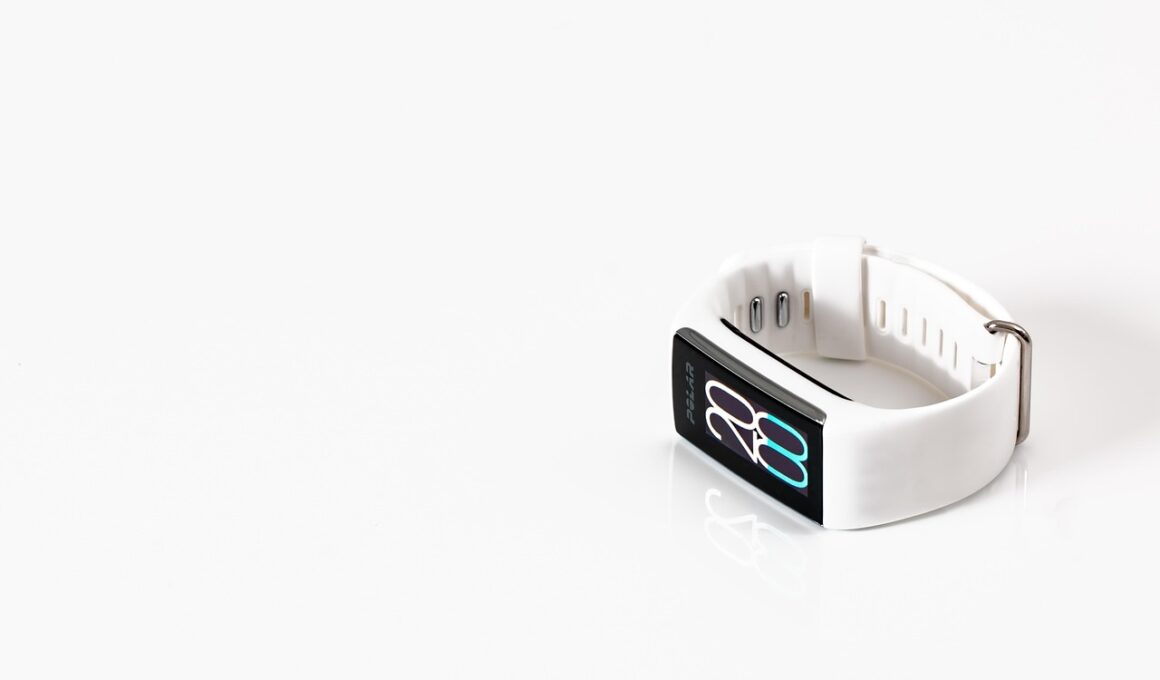Heart Rate Variability Trackers and Their Role in Cardio Fitness
Heart Rate Variability (HRV) is crucial when assessing cardiovascular fitness. Unlike heart rate, which measures how fast the heart beats, HRV indicates the time variation between heartbeats. This metric is vital for understanding how well your heart responds to stressors, both physical and emotional. Higher HRV is generally a good indicator of a well-functioning autonomic nervous system, which reflects good recovery and resilience. Thus, tracking HRV through devices can provide insights into our individual fitness levels and overall health. Monitoring HRV gives a more complete picture of an individual’s cardiovascular condition. HRV trackers are now more accessible than ever, available in various forms, including wearable devices like smartwatches and fitness bands. This technology has revolutionized how we approach training. With precise data, athletes can tailor their workouts, ensuring they optimize recovery time and performance. Understanding how these metrics fluctuate depending on workouts or stress levels helps improve training effectiveness and longevity. So, for anyone serious about cardiovascular training, investing in an HRV tracker can be an excellent decision.
Incorporating HRV tracking into your fitness routine can yield profound benefits. First, it provides valuable data that allows individuals to recognize the most effective training patterns for their body. This means you can prevent overtraining, as the tracker informs you when to push harder and when rest is necessary. For instance, if your HRV measurements drop significantly, it might be a sign to dial down your intensity and focus on recovery. Additionally, HRV tracking can enhance mental health management. Stress and anxiety can influence cardiovascular performance. With HRV data, individuals can learn how emotional states impact their physical capabilities. This information empowers you to take proactive measures to mitigate stress. Incorporating techniques like meditation, deep breathing, or even yoga can be strategically placed into your regimen. Regularly monitoring your HRV enables identification of personal patterns and responses, fostering long-term fitness excellence. Furthermore, HRV metrics offer a personalized approach to cardiovascular training that one-size-fits-all solutions lack. Each person responds differently to fitness programs, and understanding those unique responses is vital for optimal results.
The Importance of Recovery in Cardio Fitness
Recovery holds a pivotal role in shaping cardiovascular fitness levels positively. Recovery processes allow the body to repair and refuel, which is especially important after strenuous cardiovascular activities. It’s during this period that improvements in endurance, strength, and overall performance occur. Effective recovery poses significant benefits, such as enhancing HRV readings. Well-recovered athletes tend to exhibit higher HRV scores, indicating their bodies can easily adapt to physical stress. In practical terms, utilizing HRV trackers during recovery can offer insights into how well your body is recuperating. By recognizing personal recovery rates, individuals can prevent injuries and burnout, frequently caused by overtraining. Techniques designed to enhance recovery, such as proper nutrition, hydration, sleep, and low-intensity exercise, can be adapted based on HRV feedback. Additionally, mental recovery techniques, including mindfulness and relaxation practices, significantly impact cardiovascular performance too. Therefore, HRV tracking provides a comprehensive view of your potential recovery trajectory. With more informed recovery planning, overall cardiovascular fitness improves sustainably over time, especially within the realm of performance-driven training.
The integration of technology into cardiovascular training cannot be overstated. HRV trackers are among the innovative tools changing how individuals monitor their health. Among the multitude of devices available, options range in terms of specificity, wearability, and pricing. Some devices link solely to heart rate metrics, while others provide a comprehensive health dashboard, including sleep quality and stress levels. Popular options include chest straps, smartwatches, and fitness apps designed to track HRV. Having this data at your fingertips empowers users to be proactive about their fitness journeys. When you have an accurate representation of your heart health, making informed decisions regarding exercise becomes significantly easier. Moreover, data continuity enables longitudinal studies on personal fitness advancements, further enhancing future performance strategies. Many smart devices offer insights integrated with other health metrics, refining the training process. The combination of strength training, aerobic workouts, and recovery routines becomes effortlessly customizable. Ultimately, HRV trackers become personal coaches embedded in our daily lives. They serve as valuable companions that drive us towards sustained cardiovascular fitness improvements, tailored to our individual needs.
Understanding the Metrics of HRV
To maximize the benefits of HRV tracking, it’s essential to understand the core metrics involved. HRV can be measured using various methods, including root mean square of successive differences (RMSSD) and standard deviation of normal-to-normal intervals (SDNN). Each of these metrics provides profound insights into autonomic balance. RMSSD is particularly useful for monitoring short-term fluctuations that respond to stress. On the other hand, SDNN measures longer-term variability and is more comprehensive. Both metrics can be indicative of your overall fitness and stress responses. Elevated HRV measured through these metrics generally suggests better cardiovascular health and improved recovery vigor. Knowing how to interpret these metrics not only enhances workout efficiency but also fosters a balanced lifestyle. For example, if HRV metrics remain low over several days, it may indicate chronic stress or overtraining. Insights garnered from these metrics enable tailored adjustments in your training plan. Therefore, understanding these HRV indicators can play a critical role in fine-tuning both physical fitness and mental wellness, ultimately leading to long-term success in achieving your goals.
Regularly measuring HRV fosters a deeper connection between the body and mind. By observing how lifestyle, nutrition, and stress affect HRV, one becomes more self-aware regarding overall health. Positive changes in daily habits may arise from tracking HRV, as individuals become motivated to prioritize optimal well-being. For instance, holistic approaches may emerge, incorporating balanced nutrition, exercise, and stress management techniques. Additionally, leveraging data enables users to set realistic health goals tailored to personal needs. Those undertaking intense workout regimens can benefit from adaptive training strategies directly linked to HRV scores. By employing these adjustments, you create a dynamic and sustainable approach to cardiovascular health. The value in selecting the right time for workouts is crucial; many athletes utilize morning HRV scores to determine the day’s training intensity. In essence, by incorporating HRV technology into cardiovascular fitness regimens, individuals leverage data to create bespoke training plans. It encourages not just physical fitness growth but improves mental resilience too. Individuals notice enhanced motivation and performance, bolstered through their understanding of their physiological responses.
Conclusion: The Future of Cardiovascular Training
As technology advances, the future of cardiovascular fitness seems bright, particularly with tools like HRV trackers. These devices bridge the gap between traditional training methods and individualized approaches to exercise. In a world increasingly attuned to the importance of personal well-being, such metrics serve invaluable roles. Tomorrow’s athletes will likely enrich their training with a distinct focus on recovery and self-awareness broadly enabled by HRV technologies. Such personalized training regimens promise enhanced workout efficiency, pushing individuals towards their cardiovascular fitness goals. Moreover, as new technologies emerge, incorporating AI and machine learning into HRV tracking is plausible. Predictive algorithms could become available, offering even deeper insights into individual health trends and tailored recommendations. Advanced HRV trackers might identify optimal training windows and recovery moments with unrivaled precision. As researchers continue to explore HRV’s association with performance and well-being, valuable gains and improved methods will surface effectively. For cardiovascular fitness enthusiasts, this journey towards data-driven exercise sustains a progressive forward path. Ultimately, embracing technology in cardiovascular training ensures improved health and well-being for all.
The continuous evolution of HRV tracking technology also offers the potential for community engagement. Sharing HRV data with trainers or fellow athletes can pave the way for supportive environments, fostering motivation and healthy competition. The inherent support system can help maintain focus on individual goals while celebrating successes as a community. Additionally, integrating HRV tracking into team sports encourages collaboration and helps identify team dynamics affecting overall performance. This communal approach can elevate workout adherence levels. Utilizing HRV data collectively strengthens bonds and relationships among participants, creating a healthy fitness culture. Overall, leveraging technology within cardiovascular training represents a significant advancement towards achieving optimal fitness. Ensuring every individual has access to precise heart health data transforms how we collectively manage wellness efforts. As awareness regarding cardiovascular fitness and its interplay with mental well-being grows, heart rate variability trackers will inevitably gain higher traction within fitness communities. Therefore, embracing such innovations proves essential for modern fitness journeys, marking a shift towards comprehensive well-being encompassing physical and mental components. Fitness enthusiasts can thus take charge of their health, armed with the information necessary to make informed choices.


